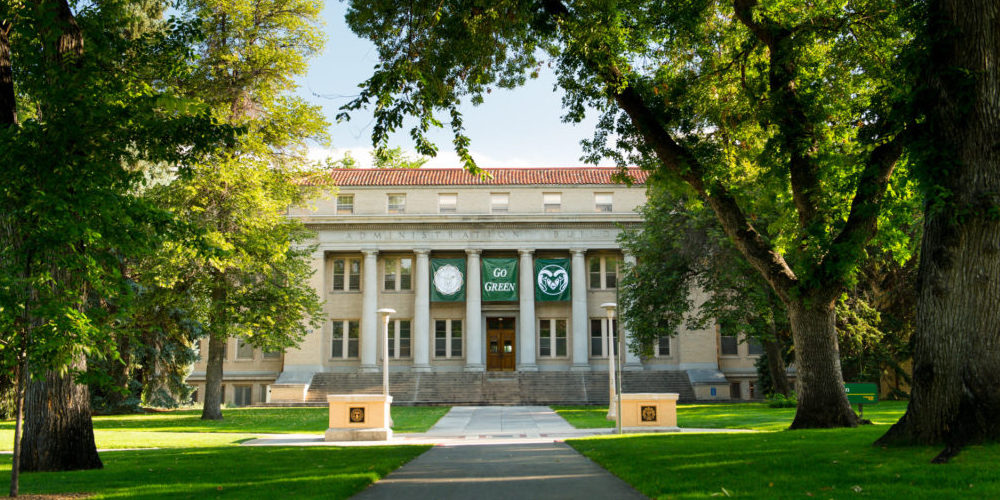
Editor’s Note: Amy Barkley, executive assistant to the CSU Faculty Council, wrote this article for SOURCE on key reports and discussion items at the Sept. 5 Faculty Council meeting. It is published here on behalf of the Faculty Council Executive Leadership. Details of the reports and presentations referenced below are available in the meeting minutes on the Faculty Council website once they are approved at the October meeting.
Faculty Council had its first meeting of the 2023-24 academic year via Microsoft Teams on Sept. 5, and heard updates about the Veterinary Teaching Hospital expansion, revisions to the Graduate and Professional Bulletin, and updates from other offices on campus.
VTH expansion
College of Veterinary Medicine and Biomedical Sciences Dean Sue VandeWoude visited Faculty Council to provide an overview of the expansion of the Veterinary Teaching Hospital, as well as the reasons behind the expansion.
VandeWoude explained that the project is being done to address a severe veterinary shortage in the workforce, as well as to facilitate a curricular overhaul. The hope is to have an additional 30 students by Fall 2026, with a projection of admitting an additional 120 students by 2030. The vision is to create a Primary Care Center where students can be trained, as well as a place for community members to bring their animals in for care. The Board of Governors approved the program plan about a year ago and a financing plan in August. Vice President for University Operations Brendan Hanlon also was present to answer questions.
Questions from council members included requests for more clarification around the funding for the project. Other members expressed concern about other space demands on campus. Hanlon explained the funding projections and how the bonds will work (see meeting minutes for more information). Hanlon also indicated that a space assessment is nearing completion by the Space Committee, to help inform conversations around space utilization in other areas of campus.
Revisions to Graduate and Professional Bulletin
The Committee on Scholarship, Research and Graduate Education brought forward three motions for proposed revisions to the Graduate and Professional Bulletin. Committee Chair William Sanford provided rationale for each of the changes.
Two of the proposed changes were around admissions requirements, specifically around GPA and letters of recommendation. The changes allow for students earning below a 3.0 GPA to be admitted, as well as allow students to submit an unofficial transcript and fewer than three letters of recommendation. The third change included similar language for international students and provided them with the ability to submit an unofficial transcript. Additional changes to this section included adding the Duolingo language test and providing an exemption from taking the exam if the student has recently earned a degree from a university where English is exempt.
Questions from members centered around differing requirements across departments and colleges that may conflict with the changes. Sanford clarified that these would be minimum requirements and that departments are allowed to have stricter requirements for admission. After the discussion focused on the Duolingo test, Faculty Council agreed to amend to the motion to clarify that the TOEFL, IELTS, Duolingo or PTE requirements would be waived when a student’s CSU graduate program is taught outside of the United States in the student’s native language.
Updates from STRATA, Health Network
Vice President for Technology Transfer Richard Magid provided a brief overview of changes at CSU STRATA. Magid reminded members that they rebranded last summer, combining the CSU Research Foundation and CSU Ventures. He emphasized the desire to connect more with the CSU campus and to align around technology transfer. He encouraged faculty to reach out if they are interested in the offerings from the technology transfer office.
CSU Health Network Executive Director Laurel Halsey also attended Faculty Council to provide information on the CSU Health Network and what it is doing for students, as well as some clarification around what role they play.
Halsey explained that they help with medical and mental health care needs of students and documenting that active care. They also provide documentation to the Student Disability Center in support of ongoing accommodations that may be needed related to the student’s physical or mental care. Halsey clarified that the CSU Health Network is not responsible for supplying absence notices for classes, as they do not document illness after the fact. Halsey indicated that some students are receiving conflicting information on their syllabi to come to them for these absences. She said she is hoping this information can be clarified so everyone is on the same page.
Other highlights
- President Amy Parsons stated in her report that as part of the Thematic Year of Democracy, Gov. Jared Polis and Utah Gov. Spencer Cox will be facilitating a fireside chat on Nov. 15 to discuss how to dialogue better on issues of disagreement.
- Chair Melinda Smith announced that work is being done to create a strategic communications plan in coordination with Pam Jackson in the Office of the Provost.
The next Faculty Council meeting will be on Tuesday, Oct. 3, over Microsoft Teams, 4-6 p.m. For the schedule of Faculty Council meetings, approved minutes and agendas, lists of members of the Council and its committees and other information, visit the Faculty Council website.